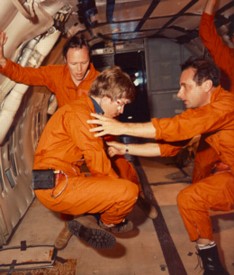In which I channel my character Esti Gusev — or at least I channeled something. I.e., sometimes the hazards of space travel can come right down to Earth.
Since becoming a Goodreads member (see my last post), I spent awhile last night adding books to my bookshelves there & in general being a book geek. Along the way, I ended up reviewing a book I’m still reading because it’s already proven valuable to my writing. I figured I’d share the review here — actually expanded from what I wrote on Goodreads. And because my blog automatically updates my Goodreads author profile (that unfortunately is still not with my reader profile), it’ll show up there too.
I started reading The Hazards of Space Travel: A Tourist’s Guide
by Neil F. Comins off my Kindle for iPhone as relaxing lunchtime reading at the Bear Tooth the day before Thanksgiving — excellent accompaniment for Yucatan lime soup, chicken Ceasar salad, & that dark smooth Moose’s Tooth Pipeline Stout!
Really, I chose it because I was in the midst of NaNoWriMo, working on a story called “Cycler” & thinking about what my character Esti Gusev, born & bred on Mars, will experience when she takes a mag launcher into space for her trip to Earth. “Martian” is synonymous with “has lived her whole life at 1/3 of Earth’s gravity” — she’s had to work her hiney off to get strong enough to withstand Earth gravity, much more so to take a launcher into space instead of riding the space elevator. So, what will it be for her to be pressed back into her seat at 2 or 3 times Earth g as she rises to orbit?
Much to my surprise, as I read the chapter in this book about gravity, I discovered that I’d had Esti work so hard that she was well-equipped to deal with the high g-force for that brief duration. What really messes her up? Microgravity. From low Mars orbit to rendezvous with the cycler in which she’ll travel to the Earth/Moon system, she gets sick as a… well, not as sick as a dog, but rather as sick as more than one-half of all astronauts & cosmonauts who’ve ever been to space. What sickens them is a condition called space adaptation syndrome (SAS), which is caused by physiological changes due to the lack of the force of gravity that the species of Earth evolved under:
While all the causes of this illness have not yet been identified, changes in the gravitational force, redistribution of the fluids in the body, and changes in the digestive system all contribute to the disorder. The symptoms include uneasiness and discomfort, as though you are coming down with a cold, drowsiness, disorientation, sweating, headaches, loss of appetite, irritability, loss of motivation for tasks, a knot in your stomach, and sudden vomiting.

Space adaptation syndrome acclimation (NASA). This isn't what Esti looks like, but this is kinda like how she feels looks like. Via Wikimedia Commons.
In this enclosed environment, the vomitus has nowhere to go, which adds to your nausea and can eventually case you to breathe in the material you are expelling or have already expelled….
Ewwww.
…. caus[ing] you to asphyxiate. To avoid these dangers, astronauts today are forbidden to carry out any activities that require space suits until three days after they have arrived in space.
My channeling-Esti pseudo-SAS was not, I must hasten to add, because of Thanksgiving dinner the day before: nobody else with whom I enjoyed Thanksgiving got sick.
I got better, Esti got better, & the book has already proven invaluable as a research tool for my ongoing writing in my Cold/Long Dark story universe. I’m reading it all out of order, though. Right now I’m reading the stuff about radiation hazards in space. The radiation dangers are so extreme for long-term travel in space, that if I were to retain complete fidelity to science, I’d have to give up this story universe altogether. Therefore I will follow that tried & true method of all science fiction writers: I’ll fudge a bit.
Some of the “Mack’s Log” stories used to illustrate the science verge a little on the cheesy side — Neil Comins is, after all, an astronomer & science writer, not a storyteller. 😉 But all else is good. This book is immensely readable, interestingly written, & is comprehensible to the intelligent non-scientist reader. I particularly recommend it to writers like me who might want to know a few things before they have their astronauts do something really stupid.
This is my review from partway through the book — perhaps I’ll write more later, after I’ve finished it. Or as additional facts in it affect my writing of my characters & my story world.


Only last week, sitting at my desk, listening to somebody giving a speech I wasn’t at all enthused about but needed to hear anyway – I began the mundane task of filing a chipped nail. Not one to miss out on a good distraction, I let my mind wander to the dust cloud forming in the narrow stream of sunlight between my hands and the window and the question that appeared in the thought bubble over my head read… “What becomes of these particles in space when an astronaut chips a nail?”
From now on I think I’ll just ask ‘What would Esti do?’
🙂